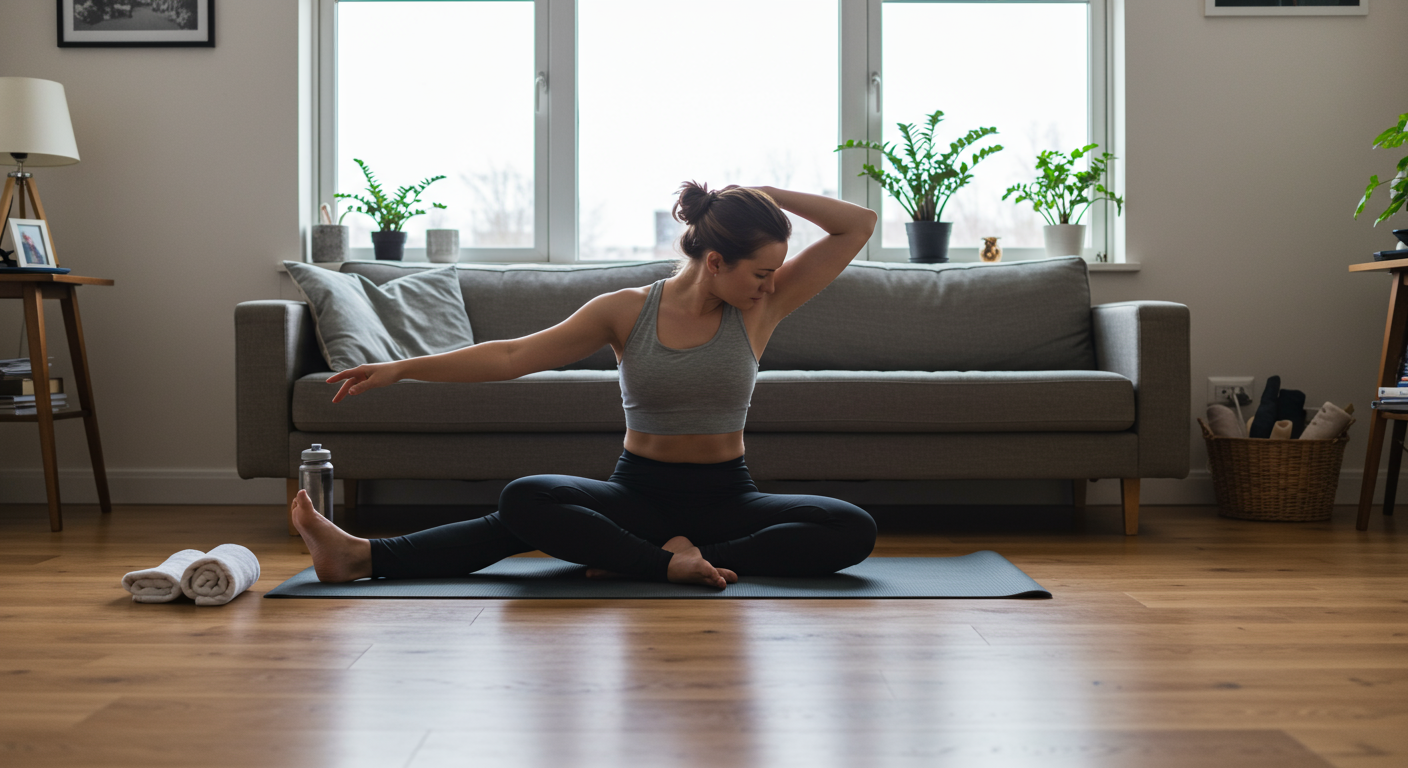Feeling stiff and inflexible? This guide is your starting point for improving your flexibility and mobility right at home. Whether you're new to fitness or spend your days at a desk, these simple exercises will help you move more freely and feel better.

Why This Workout is Perfect for Home Beginners
This routine is designed with beginners in mind. It requires no equipment and can be done in a small space. The focus is on gentle movements and proper form, making it safe and effective for those new to flexibility training. The exercises are simple, easy to follow, and can be adapted to fit your current fitness level. This is about making your body feel good.
Essential Moves You'll Need
Here are a few basic stretches to get you started. Remember to breathe deeply throughout each exercise and listen to your body. Hold each stretch for 15-30 seconds, and repeat each one 2-3 times.
- Neck Rolls: Gently tilt your head towards your right shoulder, bringing your ear towards your shoulder. Hold, then slowly roll your chin down to your chest. Bring your chin to your left shoulder and repeat.
- Shoulder Rolls: Roll your shoulders forward in a circular motion for 10 repetitions, then backward for 10 repetitions. This helps release tension in your upper back and shoulders.
- Triceps Stretch: Extend one arm overhead, bending your elbow and reaching your hand towards your upper back. Use your other hand to gently pull your elbow further down. Hold, then repeat on the other side.
- Chest Stretch: Clasp your hands behind your back, and gently lift your arms up and away from your body. This opens up your chest and can counteract the effects of hunching over a desk.
- Hamstring Stretch: Sit on the floor with your legs extended. Reach towards your toes, keeping your back straight as you can. If you can't reach your toes, reach as far as you comfortably can.
- Quadriceps Stretch: Stand and hold onto a wall or chair for balance. Bend one knee and bring your heel towards your buttock. Hold your foot with your hand to deepen the stretch, if comfortable. Repeat on the other side.
- Standing Side Bend: Stand with your feet shoulder-width apart. Raise one arm overhead and lean to the opposite side, feeling the stretch along your side. Repeat on the other side.
Step-by-Step Instructions
Follow these steps to create your own beginner flexibility routine:
- Warm-up (2 minutes): Start with gentle movements like arm circles and leg swings to get your blood flowing and prepare your muscles for stretching.
- Neck and Shoulder Stretches (3 minutes): Focus on releasing tension in these often-tight areas, using the neck rolls and shoulder rolls detailed above.
- Upper Body Stretches (5 minutes): Perform the triceps and chest stretches. Breathe deeply and hold each stretch.
- Lower Body Stretches (5 minutes): Include the hamstring and quadriceps stretches. Feel the stretch without straining.
- Cool-down (5 minutes): Finish with the standing side bends and repeat any stretches that feel particularly good. Focus on deep breathing to help your muscles relax.
Tips for Success
- Breathe: Deep, controlled breathing is key to effective stretching. Inhale deeply as you prepare for the stretch, and exhale slowly as you hold it. This helps your muscles relax and allows for a deeper stretch.
- Listen to Your Body: Never push yourself beyond your comfort level. If you feel any pain, stop the stretch immediately. The goal is to feel a gentle pull, not pain.
- Consistency is Key: Aim to do this routine 3-5 times per week for best results. Even a few minutes of stretching each day can make a big difference.
- Find a Quiet Space: Choose a quiet, comfortable space where you can focus on your body and your breath. This helps you relax and get the most out of your stretching session.
- Use a Supportive Surface: Consider using a Lululemon Yoga Mat or a similar soft surface to provide cushioning and support while you stretch, especially if you are stretching on a hard floor.
Benefits and How It Helps Your Goals
Regular flexibility exercises can provide several benefits, including reduced muscle tension, improved posture, increased range of motion, and decreased risk of injury. For desk workers, flexibility exercises are particularly important to counteract the effects of prolonged sitting. They can help alleviate back pain, neck stiffness, and shoulder tension, allowing for improved overall well-being and a better quality of life.
How to Fit It Into Your Busy Schedule
This routine can be easily incorporated into your daily life. Try these strategies:
- Morning Routine: Dedicate 5-10 minutes each morning to stretching before you start your day.
- Mid-Day Breaks: Take short stretch breaks every hour while working to break up prolonged sitting.
- Evening Wind-Down: Include this routine as part of your evening relaxation ritual.
- Combine with Other Activities: Stretch while watching TV, listening to a podcast, or even during a phone call.
Quick Warm-up and Cool-down
Warm-up: Start with 2 minutes of light cardio, like marching in place or arm circles, to get your blood flowing.
Cool-down: Finish with a few minutes of deep breathing and gentle stretching to help your muscles relax.
Next Steps in Your Home Fitness Journey
Once you've mastered these basic stretches, you can explore more advanced flexibility exercises and routines. Consider the following:
- Yoga: Explore beginner yoga classes online or in your local community. Yoga combines stretching with breathing and mindfulness.
- Pilates: Pilates focuses on core strength and flexibility. Many online resources offer beginner-friendly Pilates routines.
- Foam Rolling: Using a foam roller can help release muscle knots and improve flexibility.
- Progressive Stretching: Gradually increase the duration and intensity of your stretches as your flexibility improves.